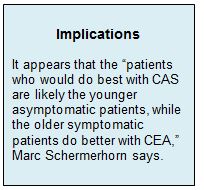Key Points:
- Meta-analysis looks at long-term outcomes of CAS vs CEA
- CAS associated with higher short-term risk, but long-term outcomes similar for both
Long-term outcomes of carotid artery stenting (CAS) and endarterectomy (CEA) are similar, according to a new meta-analysis, even though there appear to be some differences in short-term complications and restenosis/reocclusion rates for certain patients. The findings were published online July 8, 2016 ahead of print in the Journal of NeuroInterventional Surgery.
Woo-Keun Seo, MD, of Samsung Medical Center (Seoul, South Korea), and colleagues conducted a meta-analysis of 22 studies comparing the 2 treatment modalities. Maximum follow-up duration was 10 years.
A previous meta-analysis has already shown that the preventive effects of both treatments are similar during the postprocedural period, report the authors, but no results beyond 5 years were included. “Recently, long-term outcomes of randomized controlled studies, including symptomatic, asymptomatic, and all-inclusive stenosis, have been published,” they write. “Therefore, an updated systematic review and meta-analysis reflecting long-term results from these studies is needed.”
The investigators found that risk of postprocedural ipsilateral stroke was similar in both groups at all follow-up points evaluated, regardless of symptom status (RR 1.04, 95% CI 0.81-1.34). Patients who underwent CAS, however, had a greater risk of restenosis/reocclusion after revascularization than did those who underwent CEA (RR 1.46, 95% CI 1.03-2.07). There was a nonsignificant trend toward this same pattern in studies that looked only at patients with symptomatic stenosis (RR 1.44, 95% CI 0.78-2.66).
Subgroup analysis revealed that the risk of restenosis/reocculsion among patients who underwent CAS diminished gradually over time, becoming comparable to that of patients who underwent CEA at 1 year postprocedure.
Among patients with symptomatic stenosis, the combined risk of procedural stroke, death, or MI and ipsilateral stroke all were more common among those receiving CAS (RR 1.35, 95% CI 1.04-1.77). This pattern was not seen in the asymptomatic group (RR 1.14, 95% CI 0.77-1.70) or in studies that lumped symptomatic and asymptomatic patients together (RR 1.22, 95% CI 0.97-1.52). The disadvantage of CAS also disappeared when studies were divided according to follow-up time points.
An Eye Toward Periprocedural Risk
“Based on our results,” write the authors, “CAS could be a good alternative to CEA in terms of long term outcomes and durability persisting until 10 years.
“Clinical judgment in the selection of appropriate revascularization procedures is important, taking account of the competing risks of the 2 treatments,” they advise. “When performing CAS, identifying patients with a low periprocedural risk and further reducing their risk is warranted as a treatment strategy for atherosclerotic carotid stenosis.”
Commenting on the paper for Neurovascular Exchange, Marc Schermerhorn, MD, of Beth Israel Deaconess Medical Center (Boston, MA), said it “very nicely demonstrates that after the periprocedural period, CAS and CEA are almost equivalent.
“In the periprocedural period, however, as we learned from CREST, the risk of stroke was higher with CAS while the risk of MI was higher with CEA,” he continued. “Of the two, stroke had a much greater impact on long-term quality of life. This difference was greater in symptomatic patients than asymptomatic patients and also increased with age.”
Based on these lessons, Schermerhorn said, “somewhat unexpectedly the patients who would do best with CAS are likely the younger asymptomatic patients, while the older symptomatic patients do better with CEA.”
Randomized trials are showing improved outcomes for asymptomatic patients not only with CEA and CAS but also with medical management, he reported. “Thus, the CREST-2 trial and others like it will be important to determine what is the best treatment for asymptomatic patients. Additionally, the technology of CAS is improving over time, and the potential improvement with newer technology like proximal protection and flow reversal via a groin approach or a cervical incision may reduce the stroke risk with CAS even further and may help to make stenting as safe as CEA at some point.
Source:
Jung J-M, Choi J-Y, Kim HJ, et al. Long term durability and outcomes of carotid stenting and carotid endarterectomy. J NeuroInterv Surg. 2016;Epub ahead of print.
Disclosures:
Dr. Seo reports no relevant conflicts of interest.


